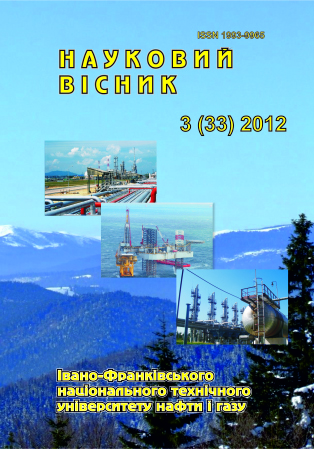DEFORMATION OF THE METAL PIPE IN SWELLING SOILS
Keywords:
Neogene clays, montmorillonite, hydrophilicity, geometric levelingAbstract
In the research section of the main pipeline located on Kerch peninsula field and lab studies have been carried out in order to determine swelling properties of karahansk and konsk Neogene clays. Fields studies were conducted in the metal pipeline area and involved long last observation of its strain due to wetting the ground base with meteoric water. These observations consisted of the second line levelling with 3 accuracy rating of surface filling marks along the pipeline profile. The lab studies of Neogene clays involved determination of their pertrographic and swelling characteristics.
Clay fraction is composed mainly of montmorillonite which has a moving electronic grid that expands because of moisture. The content of clay particles reaches appr. 85%. Clays are distinguished by the big amount of finegraded fraction (less 0.001mm), according to the thermal wetting they belong to medium water-saturated formation and their fine-graded fraction is highly hydrophilic.
As a result of conducted outdoors researches max. value of pipeline rise has been determined during
karahansk and konsk clays swelling. The obtained results are similar to those which were calculated according to the normative technique using lab research data.
It has been established that karahansk clays swell much more than konsk ones. It was also proved without
backfill strain of ground base swelling caused by atmospheric moistening was twice bigger than in fact.
Making up design schemes in the process of structural design of the pipelines being constructed in the districts of swelling soils distribution one should take into account possible uninformity if strains along the pipe which under the certain conditions can cause significant concentration of pressure on the pipe.
Downloads
References
2 Руководство по лабораторному изучению набухания и усадки глинистых грунтов. – М.: Стройиздат, 1980. – 21 с.
3 Сорочан Е.А. Строительство сооружений на набухающих грунтах / Е.А. Сорочан. – М.: Стройиздат, 1989. – 309 с.
4 Костяной М.Г. Химико-минералогический состав и гидрофильные свойства сарматских, караганских и верхнемайкопских глин Керченского полуострова.// М.Г. Костяной, А.П. Дринь. – К.: АН УССР, Институт геологических наук, 1970. – 128 с.
5 Сорочан Е.А. Вопросы проектирования и строительства на набухающих грунта / Е.А. Сорочан // строительство на набухающих грунтах. – 1967. – С. 6-14.
6 Храпатова І.В. Урахування набухання ґрунтової основи на НДС системі «основа фундаментспоруда» в умовах плоскої деформації / І.В. Храпатова // Науковий вісник будівництва. – 2007. – Вип.40. – С. 25-30.
7 Чунихин В.Г. Инженерно-геологические особенности набухания третичных глин Керченского полуострова в связи с условиями их формирования / В.Г. Чунихин // Строительсво
на набухающих грунтах. Материалы Всесоюзного совещания. – 1967. – С. 78-82.
8 Брайт П.И. Геодезические методы измерения деформаций оснований и сооружений. – М.: Недра, 1965. – 298 с.
9 Рекомендации по прогнозу осадок оснований сооружений по краткосрочным измерениям. – Владивосток: Госстрой СССР, ДальНИИС, 1986.– 22 с.
10 Руководство по наблюдениям за деформациями оснований и фундаментов зданий и сооружений. – М.: Стройиздат, 1975. – 156 с.
11 ДБН В.2.1-10-2009. Основи та фундаменти споруд. Основні положення проектування.
12 Hussein A.V. Soil Mechanices and Foundation / A.V. Hussein // Elzaim elazhari univ (part one Khartoum, Sudan). – 2002. – 253 c.
13 Ашрам Махмуд Нихад. Давление набухания в зависимости от физических свойств пылевато-глинистых грунтов / М.Н. Ашрам //
ХХХ научно-техническая конференция преподавателей, сотрудников, аспирантов ХГАКХ. Тезисы докладов. – Харьков, 2000. – С.21-22.
14 Мустафаев А.А. Фундаменты на просадочных и набухающих грунтах / А.А. Мустафаев. – М.: Высшая школа, 1989. – 590 с.
Downloads
Published
How to Cite
Issue
Section
License
Авторські права....


1.png)

















